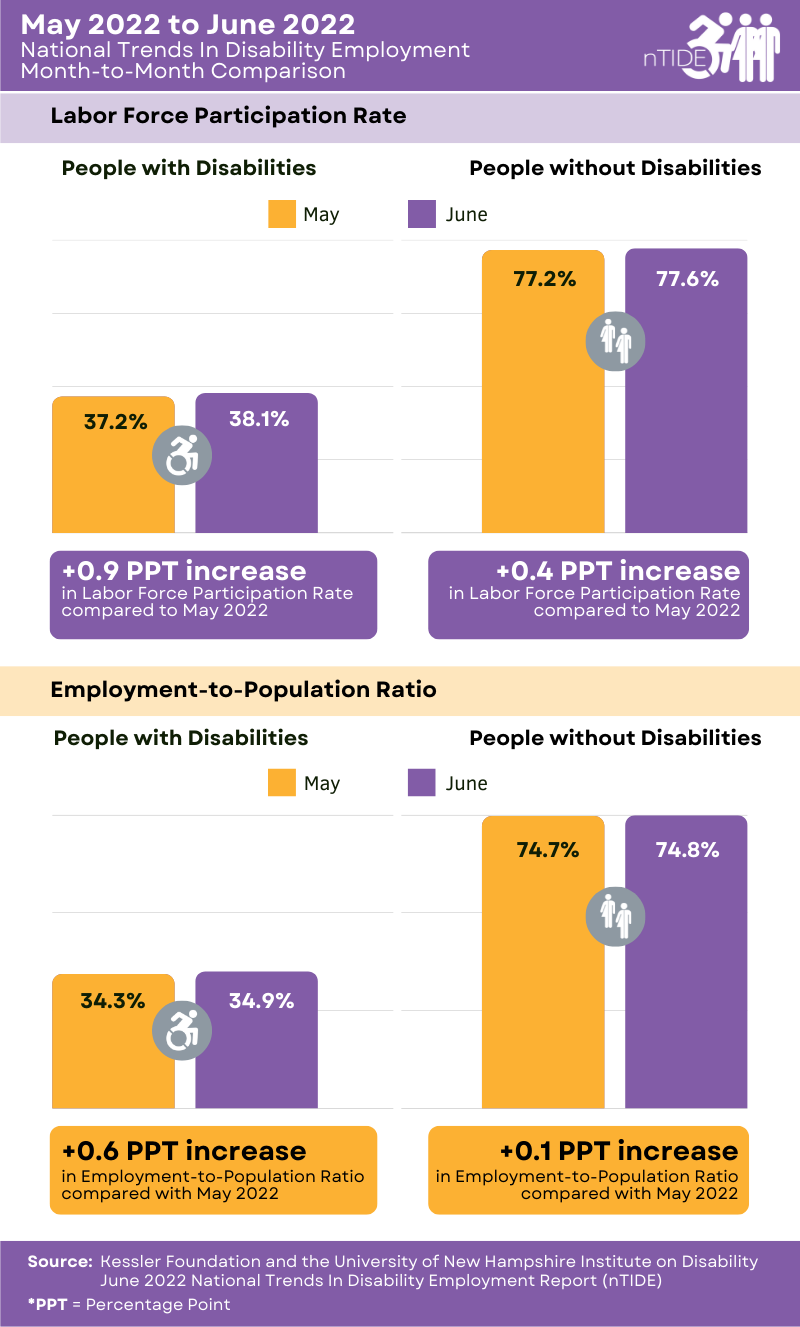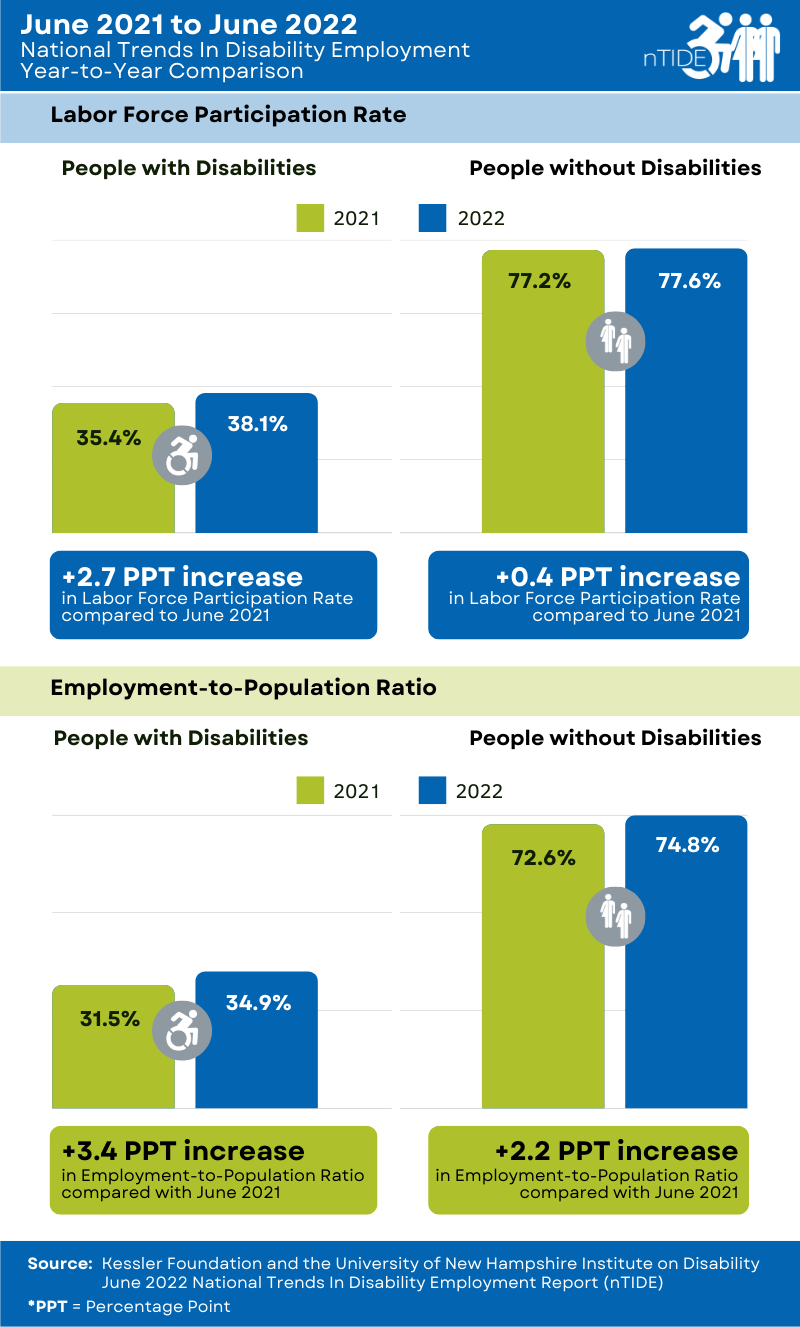National Trends in Disability Employment (nTIDE) – Issued semi-monthly by Kessler Foundation and the University of New Hampshire
East Hanover, NJ – July 8, 2022 – Employment increased slightly from May to June for people with disabilities, reaching an all-time high. The monthly increase in the labor force participation rate for people with disabilities may reflect their need for additional income because of inflation, according to today’s National Trends in Disability Employment – Monthly Update (nTIDE), issued by Kessler Foundation and the University of New Hampshire’s Institute on Disability (UNH-IOD). Comparing year-to-year data, as the economy recovers from the effects of the pandemic, people with disabilities have outpaced people without disabilities, with their employment now exceeding pre-pandemic levels.

employment-to-population ratio and an increase in the labor force participation rate for people with disabilities.
For people without disabilities, the employment-to-population ratio and the labor force participation rate
increased slightly.
Month-to-Month nTIDE Numbers (comparing May 2022 to June 2022)
In the U.S. Bureau of Labor Statistics (BLS) Jobs Report released today, the employment-to-population ratio for people with disabilities (ages 16-64) increased from 34.3 percent in May to 34.9 percent in June (up 1.7 percent or 0.6 percentage points). For people without disabilities (ages 16-64), the employment-to-population ratio increased very slightly from 74.7 percent in May to 74.8 percent in June (up 0.1 percent or 0.1 percentage points). The employment-to-population ratio, a key indicator, reflects the percentage of people who are working relative to the total population (the number of people working divided by the number of people in the total population multiplied by 100).
“June’s employment-to-population ratio for people with disabilities increased slightly, reaching an all-time high of 34.9 percent,” according to John O’Neill, PhD, director of the Center for Employment and Disability Research at Kessler Foundation. “
Findings were similar for June’s labor force participation rate. For people with disabilities (ages 16-64), the labor force participation rate increased from 37.2 percent in May to 38.1 percent in June (up 2.4 percent or 0.9 percentage points). For people without disabilities (ages 16-64), the labor force participation rate also increased from 77.2 percent in May to 77.6 percent in June (up 0.5 percent or 0.4 percentage points). The labor force participation rate is the percentage of the population that is working, not working and on temporary layoff, or not working and actively looking for work.
“The increase in the labor force participation rate of people with disabilities may reflect the need for individuals and families to pick-up extra income due to rising prices,” remarked Andrew Houtenville, PhD, professor of economics and the research director of the University of New Hampshire’s Institute on Disability.

Caption: This graphic compares the economic indicators for June 2021 and June 2022, showing increases for
people with and without disabilities.
Year-to-Year nTIDE Numbers (Comparing June 2021 to June 2022)
The employment-to-population ratio for people with disabilities (ages 16-64) increased from 31.5 percent in June 2021 to 34.9 percent in June 2022 (up 10.8 percent or 3.4 percentage points). For people without disabilities (ages 16-64), the employment-to-population ratio also increased from 72.6 percent in June 2021 to 74.8 percent in June 2022 (up 3.0 percent or 2.2 percentage points).
Similarly, the labor force participation for people with disabilities (ages 16-64) increased from 35.4 percent in June 2021 to 38.1 percent in June 2022 (up 7.6 percent or 2.7 percentage points). For people without disabilities (ages 16-64), the labor force participation rate also increased from 77.2 percent in June 2021 to 77.6 percent in June 2022 (up 0.5 percent or 0.4 percentage points).
“These comparisons to the same month last year are consistent with what we have seen throughout the economic recovery from the COVID-19 pandemic recession,” said Dr. Houtenville. “Employment and labor force participation of people with disabilities bounced back faster and now exceeds pre-pandemic levels.”
In June 2022, among workers ages 16-64, the 5,766,000 workers with disabilities represented 3.9 percent of the total 148,342,000 workers in the U.S.
Ask Questions about Disability and Employment
Each nTIDE release is followed by an nTIDE Lunch & Learn online webinar. This live broadcast, hosted via Zoom Webinar, offers attendees Q&A on the latest nTIDE findings, provides news and updates from the field, as well as invited panelists to discuss current disability-related findings and events. On July 8 at 12:00 pm Eastern, Dorothy Garcia, MPA, director of the Global Disability Equality Index with Disability:IN, joins Drs. Houtenville and O’Neill, and Denise Rozell, Policy Strategist at Association of University Centers on Disabilities (AUCD). Join our Lunch & Learns live or visit the nTIDE archives at: ResearchonDisability.org/nTIDE.
nTIDE COVID Update
Join us on July 22, at 12:00 pm Eastern for the mid-month COVID update – an in-depth comparison of the latest unemployment numbers for people with and without disabilities. Register at: COVID-19 Updates - 2022 | Center for Research on Disability.
NOTE: The statistics in the nTIDE are based on Bureau of Labor Statistics numbers but are not identical. They are customized by UNH to combine the statistics for men and women of working age (16 to 64). nTIDE is funded, in part, by grants from the National Institute on Disability, Independent Living and Rehabilitation Research (NIDILRR) (90RT5037) and Kessler Foundation.
About the Institute on Disability at the University of New Hampshire
The Institute on Disability (IOD) at the University of New Hampshire (UNH) was established in 1987 to provide a coherent university-based focus for the improvement of knowledge, policies, and practices related to the lives of persons with disabilities and their families. For information on the NIDILRR-funded Employment Policy and Measurement Rehabilitation Research and Training Center, visit ResearchOnDisability.org.
About Kessler Foundation
Kessler Foundation, a major nonprofit organization in the field of disability, is a global leader in rehabilitation research that seeks to improve cognition, mobility, and long-term outcomes – including employment -- for people with neurological disabilities caused by diseases and injuries of the brain and
spinal cord. Kessler Foundation leads the nation in funding innovative programs that expand opportunities for employment for people with disabilities.